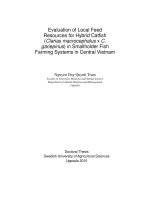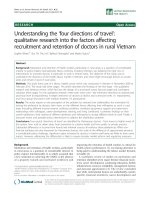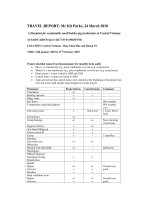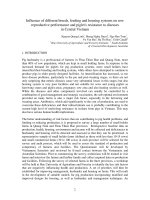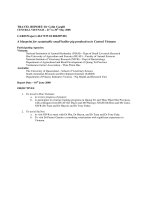CANAL AND RIVER BANK STABILISATION FOR PROTECTION AGAINST FLASH FLOOD AND SEA WATER INTRUSION IN CENTRAL VIETNAM
Bạn đang xem bản rút gọn của tài liệu. Xem và tải ngay bản đầy đủ của tài liệu tại đây (745.07 KB, 12 trang )
CANAL AND RIVER BANK STABILISATION FOR PROTECTION
AGAINST FLASH FLOOD AND SEA WATER INTRUSION
IN CENTRAL VIETNAM
V. Thuy1, I. Sobey2 and P. Truong3
1
Department of Agriculture and Rural Development, Quang Ngai, Vietnam
2
Kellog Brown Roots, Quang Ngai Natural Disaster Mitigation Project
3
TVN Director and East Asia and South Pacific Representative,
23 Kimba St, Chapel Hill, Brisbane 4069, Australia
Abstract
Quang Ngai, a coastal province in central Vietnam, is prone to flash flood caused by high
annual rainfall, with 70% (2300mm/yr) falling over three months and steep terrain
resulting in high velocity water flows. This often leads to flash floods in mountainous areas
and large scale flooding in low-lying areas. The high velocity flows and flooding cause
severe erosion on dike, canal and river banks built to protect farm land from flooding in the
rain season and sea water intrusion in the dry season. Therefore the stability of these
measures provides the local community a protection against flash flood and sea water
intrusion at the same time.
Both vegetative measures and hard structures such as rock and concrete have been used in
the past to protect these banks, but they are ineffective partly due to the local sandy soils
used to build them and partly to the strong current. Although vetiver grass has been used
very successfully for flood erosion control in the Mekong Delta of southern Vietnam,
where flow velocity is relatively slow, it has not been used under very strong current. As a
last resort, vetiver grass was tested for its effectiveness in protecting the banks of these
rivers and canals.
This paper will discuss the background and results of the two years vetiver trials carried
out in conjunction with the Quang Ngai Natural Disaster Mitigation Project.
Keywords: Canal erosion, riverbanks, stabilisation, disaster mitigation
1.0
INTRODUCTION TO THE
MITIGATION PROJECT
QUANG
NGAI
NATURAL
DISASTER
The Quang Ngai Natural Disaster Mitigation Project (QNNDMP) is located in the Quang
Ngai Province in Central Viet Nam (Fig.1). The Natural Disaster Mitigation initiative arose
out of the disastrous events of late 1999, when nearly a thousand people died and damages
exceeded US$340 million when a typhoon crossed the central coast of Vietnam. The
1
damage was a result of a combination of ‘storm’ (waves, higher tides) and flood (Tran et
al, 2006). Following these events, initiatives by the Governments of Australia and Vietnam
resulted in the formulation of a partnership with a focus on an integrated approach to
mitigation of the natural disasters (Photos 1, 2&3).
Fig.1: Location map of Quang Ngai province
Photos 1: Flood damages to river and canal banks
Photos 2: Flood damages to irrigation channel and farm dike
2
Photos 3: Flood damages to asphalted road and farm road
In 2001 Halliburton KBR Pty Ltd were commissioned by the Australian Agency for
International Development (AusAID) to prepare a Project Design Document for a project
to be based in the central provinces and to act as a demonstration project for the concept of
an integrated approach to the mitigation of natural disasters. The QNNDMP is the result of
this design and is the first major project to be implemented through the Natural Disaster
Mitigation Partnership. The geographic scope of the project is defined as the floodplains of
the Tra Khuc and Tra Bong river systems as being representative of typical river systems
in central Vietnam. The total investment in the project is approximately AUD15 million
shared 80.5% AusAID contribution and 18.5% Government of Viet Nam contribution
(Sobey, 2006)
The goal of the QNNDMP is to mitigate the impact of natural disasters in the central
provinces of Vietnam in accordance with the Natural Disaster Mitigation Partnership
objectives.
The specific objective of the project is to implement appropriate and effective
management and infrastructure solutions for the mitigation of disasters and to
strengthen community based disaster management in the Quang Ngai Province.
The project structure consists of four integrated components as follows:
•
Project Management
•
River Basin Management Planning
•
Community Based Natural Disaster Management
•
Demonstration of Disaster Mitigation Infrastructure (including Riverbank
Management Infrastructure, and Estuary Anti-salinity Infrastructure and a Safe
Harbour for Fishing Boats).
Figure 1 presents the relationship of these components, which can be divided into nonstructural (i.e. Components 2 and 3) and structural (Component 4).
3
The Project has been developed very much in line with the principle of integration, i.e.:
•
•
•
2.0
integration of the mix of desired activities (planning, community development,
mitigation works and disaster planning associated with works);
integration of works that benefit different communities and economics in the
coastal floodplains (river works, estuary anti-salinity works and estuary boat
refuge);
integration of programs that address the three prime natural disaster causes (water
allocation planning for drought; floodplain management planning and river
stabilisation for floods; and salinity control and fishing boat protection for
‘storm’ (typhoon) conditions).
APPLICATION OF THE VETIVER SYSTEM IN THE QNNDMP
The Project Design Document and in particular the Environment Assessment recognised
that there were opportunities to utilise Vetiver grass technology as an alternative to
structural engineering measures for the anti-salinity dyke and riverbank protection work
activities of the project. It was recognised however that there was limited experience and
knowledge in the use of Vetiver grass in the central provinces of Vietnam. To redress this
situation, it was recognised that demonstration trials were needed to verify the suitability of
the grass for various uses in the central provinces of Vietnam.
At the time of project commencement vetiver grass was an unproven technology for the
proposed uses, so it was expected that there would be a natural reluctance by responsible
agencies to promote its use or for communities to adopt it. The protection offered by
concrete structures is well understood and for this reason is regarded as the optimal
solution. This factor is particularly relevant for natural disaster mitigation projects where
fast, but effective solutions are required for the future protection of local communities,
particularly in the short term. It was therefore expected that there would be some
institutional reluctance to adopt an alternative vetiver based system. Because the use of
4
vetiver was a relatively unknown procedure in the local area, trials of its use were carried
out as part of the overall implementation phase of the QNNDM project.
The main advantages of Vetiver grass over concrete are the considerable saving in
construction costs and the lower maintenance requirements in the longer term. It is thus
possible to construct significantly longer sections of bank protection for the same cost
resulting in a significant increase in the area benefited for a given works budget. In
addition, the inevitable involvement of local communities in the propagation, planting and
maintenance of the grass following the adoption of Vetiver grass technology may in the
future require less demands for major inputs from governmental agencies as the
communities adopt a self-help approach using their skills and knowledge of vetiver to
carry out their own protection projects.
As noted earlier, there was a need for demonstration trials to be conducted on vetiver in the
local area. Initially planting trials were planned on three sections of the existing Binh
Chanh estuary dike exposed to differing flood and salinity regimes. The program was
expanded to include a section of an irrigation canal in a cutting where exposed slopes were
being eroded and a section of an existing riverbank flood protection dike where attempts at
establishing suitable ground cover had failed.
3.0
OBJECTIVES AND OUTCOME OF VETIVER TRIALS
The main objectives of these trials were to determine whether vetiver grass can:
• be grown in central provinces of Vietnam
• be established on the harsh conditions of canal and river banks
• can tolerate the saline conditions of the estuarine dikes
• be effective against soil erosion under strong flow and flooded conditions
• be affected by local pest and diseases
• be used for animal fodder
• be maintained cheaply and effectively by local farmers
The trials were conducted at 9 sites:
• 4 anti-salinity dikes at Binh An 1, Binh An 2, My Tan 1 and My Tan 2. Vetiver
was planted on mainly coastal sandy loam (Photo 4).
• 1 estuary river bank on Binh Trung dike to control erosion on dike face and toe,
caused by rain and flood. Floodwater often came up to 1/2 - 3/4 of dike height
which was built with clayey soil (Photos 5&6).
• 3 canal banks on Tho Nam 1 and Tho Nam 2 to control flood erosion canal banks,
My Phuoc dike to protect concrete structures (Photo 7).
• 1 river bank at Binh Thoi to control riverbank erosion, built with highly erodible
alluvial soil and often overtopped or up to 3/4 embankment by flood water.
5
Photo 4: Estuary facing dikes built to stop sea water intrusion to farm land
Photo 5: River bank stabilisation against flash flood erosion
Photo 6: Stabilisation of a large river bank against flash flood erosion
6
Photo 7: Drainage canal bank stabilisation, before and after vetiver planting
Results after 3 years of trials, and the following conclusions were reached (Vo et al, 2006):
•
•
•
•
•
•
•
•
•
•
•
•
•
•
Vetiver can be established on a wide variety of soil types from loose sand to
compacted laterite fill, including saline sand, poor hill soil, basalt and fluvial silt
with various physical characteristics.
Vetiver thrives in the climatic conditions in the central regions of Vietnam and is
tolerant of the dry hot summer season.
Good tolerance to drought, inundation, saltwater; rehabilitate quickly after drought
and flood; fast regrowth after cutting.
Strong growth, flowers early in the wet season but no seed found so far and low
growth in cold season
No parasite found on Vetiver though minor density of brown spots and stem borer;
no habitat of rat and snake found.
Vetiver is not suitable for all conditions. It was found that the roots did not
penetrate sandy soil with saline ground water.
Local salt tolerant species may be planted at the toe of slopes in saline conditions to
provide toe protection allowing vetiver to be planted on the higher slopes for scour
protection.
In reasonable growing conditions vetiver can be established to resist flood flows
within three months of planting.
Even young beds of vetiver encourage silt deposition from flood flows.
Vetiver should be cut to approximately 100 mm above the ground to encourage
fresh growth. Care needs to be taken in the timing of the cutting to ensure adequate
regrowth prior to the expected flood season.
Vetiver can be used as a fodder crop particularly while young.
Livestock will graze on vetiver if other food supply is limited.
Other fodder crops may be inter-planted with vetiver to maximise the utilisation of
the protected ground.
Vetiver can protect dike and canal banks against scour and erosion on slope faces
well. However, erosion at frequently submerged toes varies with fill materials,
salinity levels and water flow velocity.
7
The following recommendations were made to the QNNDM project:
•
•
•
•
•
Vetiver can be used to protect dike and canal banks against scour and erosion
Plant Vetiver on one or both sides of embankments;
Plant Vetiver above the concrete wall of the dikes to protect it from runoff and
flood water with high velocity (Photo 8).
Use local plants/grass to control erosion and scour on the toe above brackish water
(Photo 9).
Use Vetiver in combination with other fodder species such as Guinea grass on large
river banks to encourage farmers to look after the hedges (Photo 10).
The outcome of this series of trials resulted in provincial authorities agreeing to a further
demonstration where vetiver would be used to provide additional protection at the
upstream and downstream ends of the first project construction of conventional rigid
riverbank protection.
Photo 8: Vetiver planting above rock wall for protection
against runoff and high velocity flow
4.0
INCORPORATION OF VETIVER IN THE DESIGN OF WORKS
From the outset of the project, counterpart agencies were resistant to widespread use of
vetiver for riverbank and dike erosion control. While recognising that vetiver was useful in
slope stabilisation in roadwork and for bank protection work in the northern and southern
river deltas of Vietnam (Le et al. 2006), they considered that the flood characteristics of
the major rivers in the central provinces were significantly different with higher velocity
flows and rapid rise of floods levels. On this basis these agencies firmly believed that
experience in the northern and southern deltas was not transferable to the central provinces
therefore there was no technical basis for the design of significant hydraulic structures
8
incorporating vetiver as the principal stabilising factor and erosion protection. Counterpart
agencies were prepared to accept the use of vetiver on a trial basis at low risk areas of one
of the anti-salinity estuary dykes as this was specifically provided for in the project design
document. They were not prepared to consider it for “permanent” structures.
Results from trials through the first flood season clearly demonstrated vetiver could
provide protection under severe flood conditions even at only three months after planting.
However this did not change the official position of the counterparts. The results of the
early trials however encouraged the project to continue to actively promote the
incorporation of vetiver protection into the design of the subsequent project funded works.
The dike and canal demonstrations clearly showed that the use of vetiver was an
economic and environmentally friendly treatment that would give an equivalent degree
of protection for significantly less capital expenditure. Given that the project has a fixed
budget, adoption of vetiver protection for areas where such treatment was appropriate
would have allowed a greater area to benefit from the same quantum of external
funding.
Photo 9: Mangrove fern planted on brackish water level to protect the toe of the dike
Photo 10: Planting other fodder species in combination with Vetiver on large river banks
Tropical legume
Guinea grass
9
Through a project initiated workshop on vetiver, local agencies gained a greater
understanding of the economic, environmental and community benefits of the use of
vetiver and subsequently approved further trials on the sections of riverbank upstream and
downstream of the My Phuoc revetment that was constructed by the project using typical
rock and concrete techniques. These trials proved equally successful in protecting loose
bank material and promoting sedimentation from flood flows within three months of
planting. Counterpart agencies now accept the suitability of this technique for several
situations. Specifically they have recommended the use of a vetiver slope protection
system for a section of riverbank that could not be protected economically using
conventional rock and concrete systems. This change in attitude has come about through
the impact of the trials and the continued advocacy of project personnel and visiting
specialists.
5.0
SUPPORT FOR DEVELOPMENT OF FORMAL DESIGN GUIDELINES
The significance of the absence of specific guidelines for the design of hydraulic works is
clearly evident as illustrated by the situation described above. It was also raised by the
participants of two project workshops held to promote the use of vetiver as an
environmentally sound and economic solution to erosion control problems. These
workshops brought together local, regional, national and international agencies to review
the trials carried out by the project and to discuss the applicability of vetiver systems for
erosion control and other uses.
While the demonstrations described by the presenters at the project workshops were well
received and benefits understood, the participants came back to the point that there were no
nationally recognised guidelines forming the basis for a project design standard. Without
this basis it was considered it would not be possible for constructing agencies to obtain
approval or budget for the construction of hydraulic works utilising vetiver for protection.
It is therefore clear that if the use of vetiver is to be widely accepted, it is essential that a
set of technically based guidelines be prepared, accepted and adopted by national
regulatory agencies.
6.0
UPTAKE OF VETIVER BY COMMUNITY GROUPS
Contrary to official reluctance to take up the use of vetiver for protection works, local
community groups have quickly grasped the benefits of this system of erosion protection
and show great willingness to adopt the system and to use their own funds and resources to
develop riverbank protection works.
A particular example of this occurred at An Chau village in the Binh Thoi commune.
At this village the Tra Bong riverbank was vertical and actively eroding and a low level
earth filled flood protection dyke on the top of the riverbank was at risk. Through a local
10
initiative, the commune adopted vetiver as a new approach to address the issue and protect
their agricultural land. The commune planned, developed and executed a scheme that
included trimming the riverbank to a slope of approximately 1 on 2 and the reconstruction
of the dyke with laterite fill. The slopes and crest were then planted with vetiver on a 1m
rectangular grid. The space between the vetiver rows was planted with guinea grass that
the people could harvest for stock feed. Woven bamboo matting and mini timber stake
groynes were used as initial toe protection at the normal river level. Ultimately after the
bamboo has decayed, it is expected that the deep rooting characteristics of the vetiver will
provide protection to this zone (Photo 11).
This project was entirely community driven with only a minimal contribution from the
project to finance some materials and provide technical assistance for the planting and
maintenance of the vetiver from the Agricultural Extension Centre. The success of the
project clearly demonstrates what can be achieved at a local level using minimal resources
and appropriate technology.
In addition to the above scheme that has been successfully implemented, there are many
other communities within the project area that have expressed interest in implementing
their own schemes. As a result of the interest expressed by the community groups, a
workshop was conducted specifically to inform these groups about the potential
advantages of using vetiver for small-scale community erosion control initiatives.
Following this workshop the community mass organisations such as the Women’s Union
and the Red Cross have expressed great interest in taking up community vetiver projects.
These projects are currently being considered for support through the community based
initiatives in the forthcoming project extension.
Photo 11: Local community initiative adopted VS and initiated their own project
7.0
CONCLUSION
The QNNDMP has promoted the utilisation of vetiver as an economic and environmentally
friendly methodology for slope protection and erosion control on hydraulic structures. The
11
project has supported this view through the implementation of demonstration trials funded
by the project.
Through these trials and the continued advocacy of national and international specialists,
the advantages of using the vetiver system as an economic and environmentally friendly
methodology for slope protection and erosion control on hydraulic structures has been
recognised by concerned agencies in Quang Ngai.
At the community level there has been strong interest generated and a high degree of
willingness to adopt the technology as an economic solution to many community
problems.
Limitations to the wider uptake of this technique appear to be the absence of any nationally
recognised standard guidelines that a project designer can use as a basis for design.
8.0
REFERENCES
Le Viet Dung, Le Thanh Phong, Luu Thai Danh and Paul Truong (2006). Vetiver
system: its application in the Mekong delta, Vietnam. Proceedings Regional Vetiver
Conference, Cantho City, Vietnam, January 2006.
Sobey, I (2006). Utilisation of Vetiver System in Disaster Mitigation in Central
Vietnam, Institutional Issues. Proceedings Regional Vetiver Conference, Cantho City,
Vietnam, January 2006.
Tran Tan Van, Le Viet Dung and Pham Hong Duc Phuoc. (2006).Vetiver System for
Natural Disaster Mitigation in Vietnam - An Overview. Proceedings Regional Vetiver
Conference, Cantho City, Vietnam, January 2006.
Vo Thanh Thuy, Ho Si Than and Nguyen Xuan Ba (2006).Vetiver grass trials Control
erosion and scour on waterworks in Quang Ngai province/ Proceedings Regional Vetiver
Conference, Cantho City, Vietnam, January 2006
A Brief Introduction to the First Author
Mr Vo Thanh Thuy is Vice Director of the Quang Ngai Agricultural Extension Centre,
Ministry of Agriculture and Rural Development, Vietnam. Over the last 5 years he has
conducted R&D on the application of VS to mitigate flash flood and sea water intrusion in
Quang Ngai, a coastal province of Vietnam. As a result of his works VS has been used
successfully as a disaster mitigation method in the coastal Vietnam.
12




